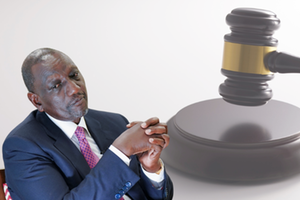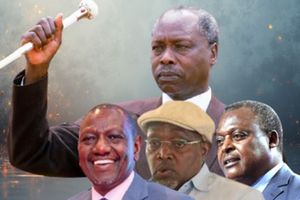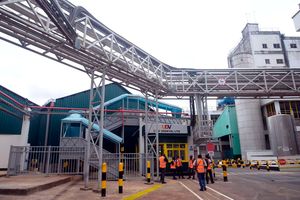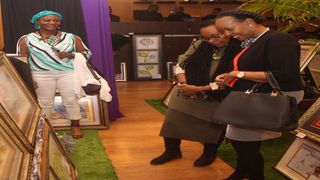
Art enthusiasts admire artwork during at Michael Joseph Centre in Nairobi in 2019.
|A centre for curation of art
What you need to know:
- When Safaricom set up the Michael Joseph Centre, is said it hoped the space would give different people a cost-effective platform to showcase their art.
- It did. In spectacular fashion. Free of charge.
The Michael Joseph Centre at Safaricom House is set aside specifically for creative arts activities and exhibitions. Officially opened in 2008, two years before the former CEO after whom it was named retired from the position, the centre has since then been buzzing with some sort of event almost every day of the week, save for the disruptions of Covid-19.
There is a reason for that buzz: for a long time, artists had yearned for space in the city where they could not only showcase their paintings, sculptures, or photographs, but also attract buyers, all without the yoke of rent pulling them back.
Safaricom observed that there were customers and clients streaming into Safaricom House every day who could make potential clients for artists. On top of that, there had been a reawakening of artistic interest in Kenyans around that time, and staff at Safaricom House could also become part of the daily footfall into the centre.
In a 2012 interview with Henry Muuthia about how art addresses critical things like urban culture and politics, Zaheeda Suleman, Head of Brand Experience at Safaricom, said: “We’re hoping this space will give different people a cost-effective platform to showcase their work.” It did. In spectacular fashion.
The truly remarkable bit about getting space at Michael Joseph Centre is that you don’t have to pay a dime. Space is allocated at no cost to anyone who wants to use it (of course you first have to send an inquiry to the management of the centre with details of your exhibition or event at [email protected]).
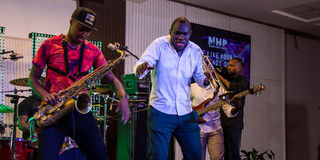
Nairobi Horns Project perform at the Michael Joseph Centre in 2016.
The proposal has to fall under the creative arts, and you can get up to two weeks for exhibitions.
Other things you will have to provide information on include the number of guests you would be expecting to attend and the resources you might require. The centre can provide sound, lighting, catering, décor and stage, but some of these may only be provided at a cost, so it is imperative that you state exactly what you would need in order to get the correct information and avoid disappointment on your big day.
Even though it is accessed through a different entrance from what staffers and those coming to carry out official business at the headquarters use, the security protocol is not any less stringent than that of the main headquarters. A security guard with the list of guests stands outside the security hub on the day of the event, checking identification cards or passports of the attendees, who must be on the guest list. Therefore, those hosting and attending functions at the centre must have confirmed before who will be coming. There is are body and luggage scanners inside the security hub to ensure that no contraband make it inside.
At the lobby and even inside the centre, you will find different pieces of art that were actually purchased from exhibitions that were held there. The stand out sculptures include the charging bull and a recycled bottle sculpture.
Amazing artists
There have also been amazing artists and photographers who have held exhibitions at the centre over the years. Some include Ubuntu Creative Arts from Jamaica who are breaking the stigma surrounding non-traditional creative fields, Greatest Maasai Mara Photographer of the Year Awards by Angama Foundation gallery, Kumbukumbu Wildlife and Nature Photography exhibition, Dream Ink MnA exhibition, and Different Strokes II Art Exhibition of Virtual Contemporary Art by New York-based artist Mike Childs in 2013.
On August 10, 2019, the World Youth Alliance Africa held the Sixth Annual Africa Arts Forum at the Centre. With the theme of ‘Celebrating the beauty of Art in Diversity’, the activity sought to promote African artists by creating a platform for artists to showcase their art, crafts, music, dance, poetry and spoken word.

